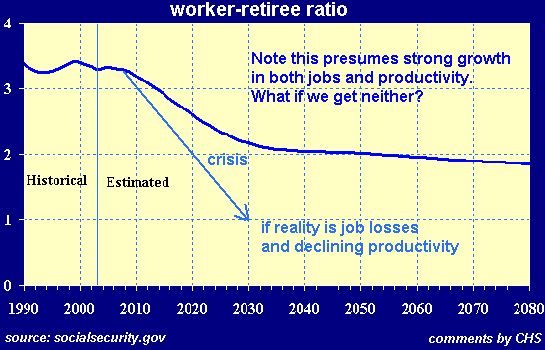

|
| weblog/wEssays archives | home | |
|
The End of Entitlements (July 27, 2007) Readers sent in three more Haiku which capture the end of the stock market's global euphoria with uncanny artistry: Tim H. Summer vacation Fools and children do not heed The approaching storm Fastwater Dog days, summer's here. Markets wobble, credit fears. American dream. UKC "It's never different this time" the flying stone laughs skips and splashes without care the water will wait Frequent contributor and fellow blogger Fred Roper sent in this stunning example of mindless euphoria. Countrywide Financial (CFC) is the nation's largest mortgage outfit. The company has been hyped by moronic pundits for months. But if we examine what insiders are doing, we note insiders sold $700 million of their own stock and purchased a grand total of $73,000. As Fred noted: This is a buy signal, right? form 4 (insider buys and sells) for Countrywide Finance Total buy: $73,417, total sell: $693,954,180, net total: $-693,880,762 On to the main topic of the day: the End of Entitlements. I have recently been discussing long cycles, and the potential for a severe crisis in the U.S. around 2021. Based on three long cycles now in motion, I believe one outcome of the 2021 crisis will be the end of entitlements--both the payments, and the mindset of "I deserve this." Before you gag on your coffee/tea/water, take a look at this chart of the Federal government's own rosy predictions: 
Recall that 76 million Baby Boomers, fully 25% of the U.S. population, begin drawing Social Security in 2008, and Medicare in 2011. According to this article, there will be 54 million retirees tapping Social Security and Medicare in 2020: The jolt of boomer retirement is headed our way. According to the Bureau of Labor Statistics, the civilian labor force is currently about 153 million. On the face of it, even with little job growth, we should still have 3 workers for every retiree in 2020. But the assumptions this is based on are faulty. 1. Medicare costs are skyrocketing, with no counter-trend in sight. As I have reported before, "Medicare program costs have risen from $70 billion in 1985 to $162 billion in 1994 to $390 billion in 2007 and are estimated to rise to $500 billion in 2011." U.S. Healthcare: Two Reports from the Front (February 1, 2007). At this rate of growth, Medicare will exceed all Pentagon/Defense spending in just a few short years, and will dominate all Federal spending by 2021. This growth is clearly unaffordable, unless we stop spending on virtually every other Federal program except interest on the National Debt. Please see my other recent entry on Medicare, Medicare Waste--50%? (January 24, 2007) 2. Global competition is a huge challenge to U.S. productivity and job growth. Globalization is still in its infancy as a trend, and the notion that the U.S. economy can add tens of millions of jobs and luxuriate in ever-rising productivity gains for decades to come is at best suspect. Much of the vaunted "job growth" since 2000 has been in money-churning, essentially unproductive fields such as real estate, mortgage generation and Wall Street financing. Most of the rest has been in construction (now fading fast as the nation wakes up to extreme overbuilding) and retail (filling up thousands of new retail outlets with clerks). To claim that these trends are sustainable is quite a stretch. 3. The 20+ year credit cycle has turned. Money will now become dearer for the next 17-20 years. Credit cycles tend to run about 17 to 23 years in length, and interest rates have slowly been rising since late 2003. That suggests rates will rise, perhaps slowly, perhaps quickly, for at least another 14 years--in other words, until the key year of crisis, 2021. The U.S. has sustained the insane growth of Medicare and Iraq/GWOT (global war on terror) by borrowing trillions of dollars from non-U.S. entities. As the credit cycle turns, this borrowing will rise in cost, becoming unaffordable as the rising interest costs squeezes all other spending. Consumers and businesses will also find new borrowing increasingly prohibitive, and as a result consumer and business spending will be curtailed--not for a month or two, but for 15 years. As Medicare costs rise at 10%+ per year, no amount of plausible job and/or productivity growth can keep pace. Employment and productivity have tended to rise at 2% a year, but there are no guarantees that this trend can hold for the next 15 -20 years. It is also possible that rising competition, borrowing costs and the decline of the money-churning economy will result in 2% annual losses in jobs and productivity. Predicting long-term trends is a tricky business. Most trends change course unexpectedly, and predictions based on the recent past turn out to be faulty. Can we really rely on the spectacular gains in wealth, productivity and employment from 1982-2006 to continue unabated for the next 15-20 years? I would suggest counter-trends are already in force which will lead to the opposite: a decline in wealth, productivity and employment which will lead to a fiscal crisis by 2021. We as a people will have to come to grips with the harsh reality that we cannot afford the entitlements which were promised. I would also suggest that a cultural change may occur in the value system of the nation, a change in which people throw off the overweening sense of entitlement which pervades our culture, and embrace (because they have no other choice) self-reliance and self-responsibility. Here are two additional links on Social Security's future: Social Security at 70. Productivity growth and Social Security's future. For more on this subject and a wide array of other topics, please visit my weblog. copyright © 2007 Charles Hugh Smith. All rights reserved in all media. I would be honored if you linked this wEssay to your site, or printed a copy for your own use. |
||
| weblog/wEssays | home |